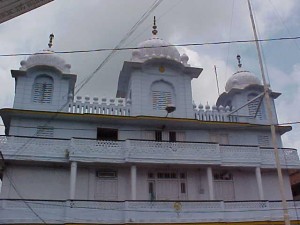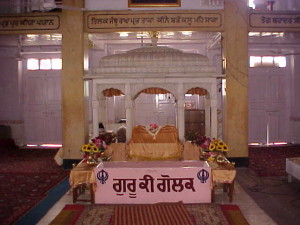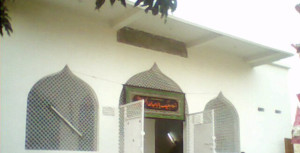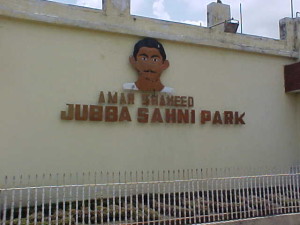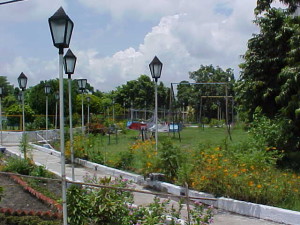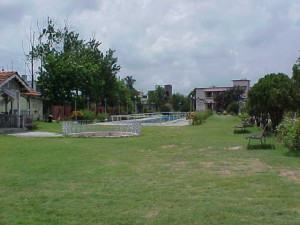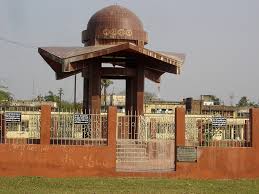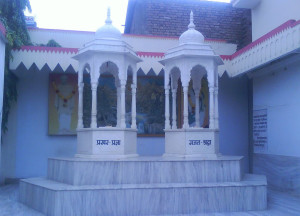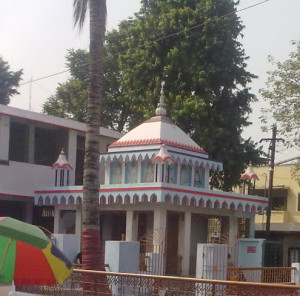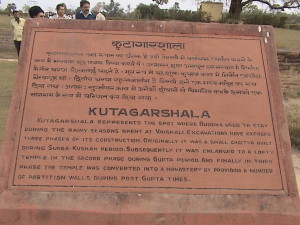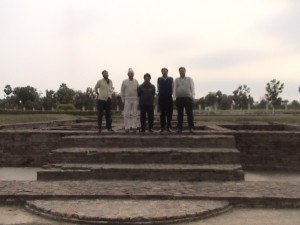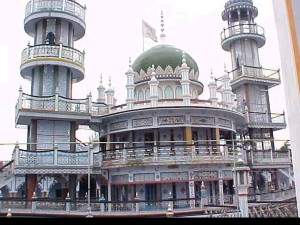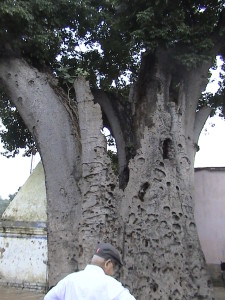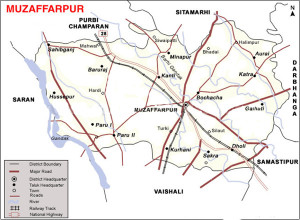 Muzaffarpur district, ‘The Land Of Leechi’ was created in 1875 for the sake of administrative convenience by splitting up the earlier district of Tirhut. Muzaffarpur is the headquarters of the district, situated on the banks of a Himalayan foothills Someshwar Range originated, perennial river Budhi Gandak. One of the major attractions of Muzaffarpur is the Lahthi (Lakh ki Churiyan/Bangles)
Muzaffarpur district, ‘The Land Of Leechi’ was created in 1875 for the sake of administrative convenience by splitting up the earlier district of Tirhut. Muzaffarpur is the headquarters of the district, situated on the banks of a Himalayan foothills Someshwar Range originated, perennial river Budhi Gandak. One of the major attractions of Muzaffarpur is the Lahthi (Lakh ki Churiyan/Bangles)
How To Reach
By Air (Airport):-
Muzaffarpur has a non-operational civil Aerodrome, Patahi, belonging to the Airport Authority of India with an air strip of 4000 ft. length. Patna Airport is 69 km from Muzaffarpur.
By Rail:-
Muzaffarpur Junction railway station, station code MFP, is a railway station in the Sonepur division of East Central Railway.
By Road :-
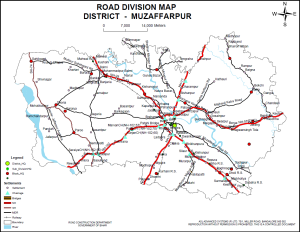 Well connected to other city through National Highway – 28, 57(EWC),77,107 State Highway-74 and other road -Muzaffarpur Pusa Rd,Motipur Sahebganj Rd,Bochaha Keotsa Road,Majhauli Katra Road,Deoria- Jaffarpur Ambara,Garha Hathauri Rd,Jhapha Minapur Road,Muzaffarpur Mahua Road,Sheohar Minapur Road,Rewa Road
Well connected to other city through National Highway – 28, 57(EWC),77,107 State Highway-74 and other road -Muzaffarpur Pusa Rd,Motipur Sahebganj Rd,Bochaha Keotsa Road,Majhauli Katra Road,Deoria- Jaffarpur Ambara,Garha Hathauri Rd,Jhapha Minapur Road,Muzaffarpur Mahua Road,Sheohar Minapur Road,Rewa Road
Popular tourist destinations
MUSAHARI BLOCK
Malang Baba :- It is situated on NH77. All travelers make a point to stop here and seek the blessings of Malang Baba and then head towards their journey.
Bramsthan:-
Durga Mandir:-
Baba Garib Nath Temple :-
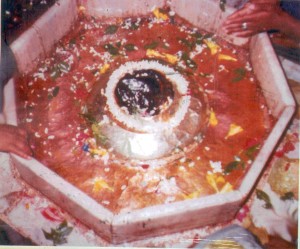 Temple of Lord Shiva situated in the center of the Muzaffarpur town.Its history goes like this, there was a Landlord in ancient times who owned the land where the present temple is. There was a huge Banyan tree in the premises of the temple which provided shade and relief to many people.
Temple of Lord Shiva situated in the center of the Muzaffarpur town.Its history goes like this, there was a Landlord in ancient times who owned the land where the present temple is. There was a huge Banyan tree in the premises of the temple which provided shade and relief to many people.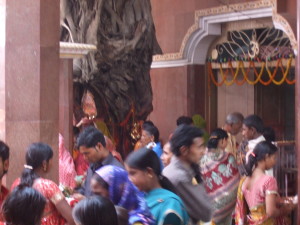 Unfortunately due to bad financial condition the Landlord had to sell his house to another person. The new owner seemed not too interested in Banyan tree so he ordered it to be cut down to clean the premises. While cutting the tree a “Shivling” was found within it, which got partly damaged due to the swing of the axe, and red water started oozing out from the “Shivling”.The Landlord was quite disturbed after seeing this and was not able to sleep for the entire night. In the morning “Baba Garibnath” appeared in his dreams and said that he was Baba Garibnath, one who has great sympathy for poor. He ordered him to establish the “Shivling” at the same place and call one of his great Devotees “Shri Shiv Dhari Pathak” of Chapra district to regularly worship and take care of the temple. It was done exactly as told by “Baba” and since that day “Baba Garibnath Temple” is famous for granting the fulfilment of the wishes of its devotees. It is also called second “Baidhnath”.A large number of pilgrims visit this place in the month of Shravana (July-August), in order to fetch water from the Ganges. After walking bare feet for about 90 km , Pahleja Ghat to Muzaffarpur, to offer prayers and pour the Gangajal (Holy Water) on the deity.
Unfortunately due to bad financial condition the Landlord had to sell his house to another person. The new owner seemed not too interested in Banyan tree so he ordered it to be cut down to clean the premises. While cutting the tree a “Shivling” was found within it, which got partly damaged due to the swing of the axe, and red water started oozing out from the “Shivling”.The Landlord was quite disturbed after seeing this and was not able to sleep for the entire night. In the morning “Baba Garibnath” appeared in his dreams and said that he was Baba Garibnath, one who has great sympathy for poor. He ordered him to establish the “Shivling” at the same place and call one of his great Devotees “Shri Shiv Dhari Pathak” of Chapra district to regularly worship and take care of the temple. It was done exactly as told by “Baba” and since that day “Baba Garibnath Temple” is famous for granting the fulfilment of the wishes of its devotees. It is also called second “Baidhnath”.A large number of pilgrims visit this place in the month of Shravana (July-August), in order to fetch water from the Ganges. After walking bare feet for about 90 km , Pahleja Ghat to Muzaffarpur, to offer prayers and pour the Gangajal (Holy Water) on the deity.
Data Kamal Shah Mazar(Tomb) :- At Purani bazar there is a mausoleum of Hazrat Data Kambal Shah Rahmatullah Alaih who was a Muslim saint. It is said that he did hold position of a Qutab in the Muzaffarpur city in his times. Many stories of his miracles are prevalent in the society. The annual Urs of the saint is held here every year after the 7th day of the “Id” festival that continues for next 6 days.
Ramana’s Tripur Sundari Temple(Devi Mandir) :-
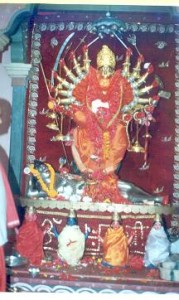
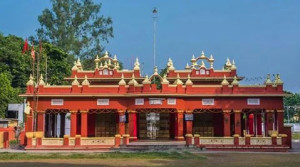 This is very important temple of city situated at Ramna.. A wealthy man, Shri Umashankar Prasad alias Bachha babu, great pujari of Mata Durga, built this Beautiful and magnificent temple on 28th June 1941. It aesthetic beauty and richness attracts millions of Devotees. It is said that it is really surprising to see that a man made temple attracts such big gathering of Devotees. This temple is also famous by the name of “Devi Temple” and Ma’s beautiful idol mesmerizes one and all. In every Navratra there is great puja organized by the city people which is a clean proof of unity and faith.
This is very important temple of city situated at Ramna.. A wealthy man, Shri Umashankar Prasad alias Bachha babu, great pujari of Mata Durga, built this Beautiful and magnificent temple on 28th June 1941. It aesthetic beauty and richness attracts millions of Devotees. It is said that it is really surprising to see that a man made temple attracts such big gathering of Devotees. This temple is also famous by the name of “Devi Temple” and Ma’s beautiful idol mesmerizes one and all. In every Navratra there is great puja organized by the city people which is a clean proof of unity and faith.
Shri Ram temple (Sahu Pokhar):-
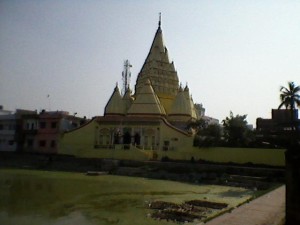 It is one of the famous religious places, situated at “Sahu Pokhar” in Muzaffarpur. Its status was kept as one of the “Navratna” temples. It is said that it was made by artists from Rajasthan. Later Shri Shiv Prasad Sahu of Sahu family took over the order and care taking of the temple and still Sahu family is doing the same. Within the premises the biggest temple is of “Shri Ram and Mata Janaki”. Beside that “Mahadev” temple is there whose Shivling is India’s third largest Shivling.
It is one of the famous religious places, situated at “Sahu Pokhar” in Muzaffarpur. Its status was kept as one of the “Navratna” temples. It is said that it was made by artists from Rajasthan. Later Shri Shiv Prasad Sahu of Sahu family took over the order and care taking of the temple and still Sahu family is doing the same. Within the premises the biggest temple is of “Shri Ram and Mata Janaki”. Beside that “Mahadev” temple is there whose Shivling is India’s third largest Shivling.
Simri Mai Temple(MIT):- It is situated near Muzaffarpur Institute of Technology in Avaas Nagar at Police Line. It is a famous “Devi Peeth”. History tells that long ago there was an old lady who used to live in a hut near this place. During night she used to meditate for long hours. She took “Samadhi” on the 17th day of Navratra here. From that day this place has got a status of “Lokgeet” and is famous by the name of “Simri Mai”.
Kali mata temple(Temple of Raj Darbhanga) :- It is situated on the south coast of “Gandak” river. This temple is believed to be built by Darbhanga Maharaj Kamlesh Singh in 1932. Many of devotees from far and near visit the shrine every day.
Christ church :-
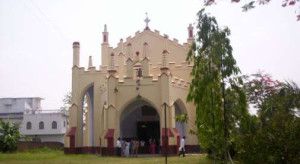 This Church building is the replica of the old Church built in 1857 which had to be demolished in 1927 due to erosion caused by Gandak river. Its foundation was laid on 7.11.1926 and was constructed on 19.02.1928 by the Most Rev. Foss Westcott, DD, Lord Bishop of Calcutta.
This Church building is the replica of the old Church built in 1857 which had to be demolished in 1927 due to erosion caused by Gandak river. Its foundation was laid on 7.11.1926 and was constructed on 19.02.1928 by the Most Rev. Foss Westcott, DD, Lord Bishop of Calcutta.
Baglamukhi Mandir ( In Kachchi Sarai)
Shyam Temple(Sutapatti)
Rani Sati Mandir (Sikandarpur)
Sikandarpur Man:-
Durga Mandir (BMP6)
Ancient Temple (Amgola)
Durga Mandir (Gola road)
Late Suresh Achal’s Statue :-
Rajendra Park :- It is situated in front of collectorate . The main attraction of Rajendra Park is a big statue of Mother India (Bharath Mata), in a chariot with Indian flag, drawn by four lions.
Imitation of Ashoka Pillar 🙁In Front of Railway station)
Chandwara Masjid Near Pakisari Chowk
Chaturbhuj-sthan :-
 A big idol of Lord Chaturbhuj was found in a village Turki in 1303 century.People started worshipping the lord with full devotion but it seems the lord desired something else! There was a saint who was a great devotees of Lord Shiva . “Lord Chaturbhuj” came in his dreams and asked him to place him near “Lord Shiva” as he was not comfortable at Turki. The saint brought the idol, all the way from Turki to Muzaffarpur, on foot which was a reflection of his faith and worship. “Lord Chaturbhuj” was established beside “Lord Shiva” under a tree and since then his regular worship started. There was a childless man from Patna, who was also great devotees of the lord. Lord came in his dreams and asked him to build a temple. It was done by him as directed and after that he got a child.
A big idol of Lord Chaturbhuj was found in a village Turki in 1303 century.People started worshipping the lord with full devotion but it seems the lord desired something else! There was a saint who was a great devotees of Lord Shiva . “Lord Chaturbhuj” came in his dreams and asked him to place him near “Lord Shiva” as he was not comfortable at Turki. The saint brought the idol, all the way from Turki to Muzaffarpur, on foot which was a reflection of his faith and worship. “Lord Chaturbhuj” was established beside “Lord Shiva” under a tree and since then his regular worship started. There was a childless man from Patna, who was also great devotees of the lord. Lord came in his dreams and asked him to build a temple. It was done by him as directed and after that he got a child.
Gurudwara(Ramna) :-
Rama Krishna Ashram(Bela Mithan Pura) :-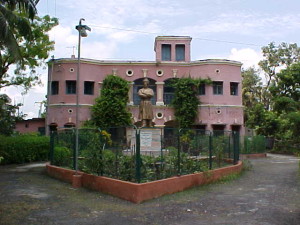
It is situated on Bela Rd, Sherpur, Lakshmi Narayan Nagar, Muzaffarpur, Bihar 843116.It is Started in 1926 as Ramakrishna Vivekananda Sevashrama, the centre was made a branch of Ramakrishna Mission in July 2003.It has been serving the people of North Bihar through its religious, medical and humanitarian services with the twin ideals of self-realization and service to humanity as preached by the great Swami Vivekananda.It have a charitable eye hospital with 30 beds,Two charitable homeopathic dispensaries in the town, a library,Two non-formal education centre, A free coaching centre. The beautiful temple of Shri Ramakrishna in marble image stands in its premises as the source of inspiration to monks, devotees and friends. Annual celebrations of the birthdays of Shri Ramakrishna, Holy Mother Shri Sharada Devi and Swami Vivekananda and other saints and sages attract devotees in large number. Rama-Naam Sankirtana is sung on each Ekadashi day. Shri Shri Kali Puja in image is a regular feature.
Santoshi Mata Mandir :-
Badi masjid(Company Bag) :- It is a famous Muslim Worship place.
Badi Karbala (Saraiyaganj )
Bada Imambara (Banaras Bank Chowk):-
Jubba Sahni Park :-
Ram Chandra Shahi Museum :- It is situated in its own building in the campus of Jubba Sahni Park. It was established in the year 1979. The museum possesses a very good collection including artifacts and numerous art-objects of varied nature. The museum is famous for its rich collection of rare postage stamps.
Khudi Ram Bose Memorial :- In the year 1908, Khudiram Bose and Prafulla Chaki was executed at Muzaffarpur Jail on the charge of throwing a bomb on Kingsford, the then British District and sessions Judge of Muzaffarpur.A memorial tablet in the memory of Khudiram Bose and Prafulla Chaki has been raised opposite the present residence of the district and sessions Judge, on the road where they thrown the bomb named as Prafulla Chaki Marg. In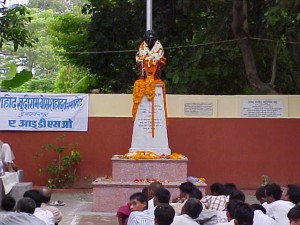 1908, the first bomb outrage, a sign of militant Nationalism, occurred at Muzaffarpur and Khudiram Bose, a Bengali boy, offered his life for the freedom of India.
1908, the first bomb outrage, a sign of militant Nationalism, occurred at Muzaffarpur and Khudiram Bose, a Bengali boy, offered his life for the freedom of India.
Mahatma Gandhi Ashram :-
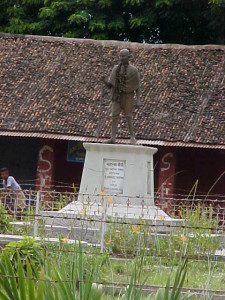 The visit of Mahatma Gandhi along with eminent nationalists like Anugrah Narayan Sinha,Sri Krishna Singh to Muzaffarpur in December 1918 on his way to Motihari to redress grievances of the Champaran indigo farmers and again in January 1927 had tremendous political effect in arousing the latent feelings of the people and the district continued to play a prominent role in the country’s struggle for freedom. Muzaffarpur also played a critical role in the Khadi revolution. Many local freedom fighters of Muzaffarpur were pivotal in Indian independence struggle in India
The visit of Mahatma Gandhi along with eminent nationalists like Anugrah Narayan Sinha,Sri Krishna Singh to Muzaffarpur in December 1918 on his way to Motihari to redress grievances of the Champaran indigo farmers and again in January 1927 had tremendous political effect in arousing the latent feelings of the people and the district continued to play a prominent role in the country’s struggle for freedom. Muzaffarpur also played a critical role in the Khadi revolution. Many local freedom fighters of Muzaffarpur were pivotal in Indian independence struggle in India
Bharat Mata:-
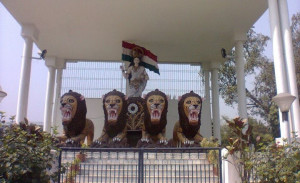 A very beautiful and glorious Statue of Bharat Mata standing on chariot having four Lions is situated in the Muzaffarpur collectorate campus. This glorious statue was gifted to the people of Muzaffarpur by Sahara India Pariwar and its maintenance is being done the same organization..
A very beautiful and glorious Statue of Bharat Mata standing on chariot having four Lions is situated in the Muzaffarpur collectorate campus. This glorious statue was gifted to the people of Muzaffarpur by Sahara India Pariwar and its maintenance is being done the same organization..
L.S.College :-
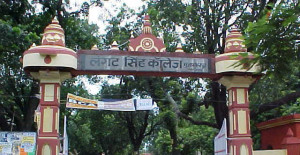 L.S.College is establised on July 3, 1899. In the year of 1900, the college was affiliated to Calcutta University. It was declared Government College in 1915 and subsequently affiliated to Patna University in 1917. In 1952, Bihar University was established with headquarters at Muzaffarpur and the college was affiliated to this new University. This is the oldest college of
L.S.College is establised on July 3, 1899. In the year of 1900, the college was affiliated to Calcutta University. It was declared Government College in 1915 and subsequently affiliated to Patna University in 1917. In 1952, Bihar University was established with headquarters at Muzaffarpur and the college was affiliated to this new University. This is the oldest college of 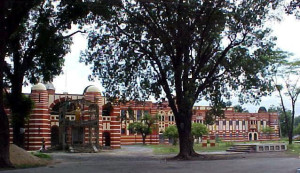 Muzaffarpur affiliated to the University of Bihar, now Bhimrao Ambedkar University. This college is also know as Bhumihar Brahmin Collage. The Langat Singh College had the likes of Dinkar, a famous Hindi poet, Dr. Rajendra Prasad,the first President of India, and Acharya J. B. Kriplani as its faculty members.The college has a huge and magnificent building incorporating the feature of Indo-Saracenic architectural style.
Muzaffarpur affiliated to the University of Bihar, now Bhimrao Ambedkar University. This college is also know as Bhumihar Brahmin Collage. The Langat Singh College had the likes of Dinkar, a famous Hindi poet, Dr. Rajendra Prasad,the first President of India, and Acharya J. B. Kriplani as its faculty members.The college has a huge and magnificent building incorporating the feature of Indo-Saracenic architectural style.
Planetarium:-
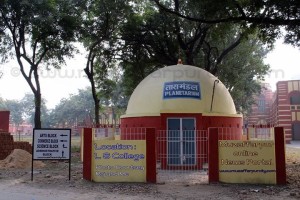 L.S.College Planetarium established during 1914-1916 which has now the heritage value for the institution and society as it is one of the oldest planetariums in India.
L.S.College Planetarium established during 1914-1916 which has now the heritage value for the institution and society as it is one of the oldest planetariums in India.
Gandhi Koop (L.S.College campus) :-
L.S college had its historic tryst with Mahatma Gandhi when he came to the college campus on the 11th of April 1917 on his way to Champaran Satyagraha and stayed with J.B. Kripalani and H.R. Malkani.
Gayatri Mandir:-
Baba Mukti Nath Mandir:-
Nawada Dih:- The KP Jayaswal Research Institute, during in the course of its Archaeological Explorations brought to light the site period Shunga. Pahaladpur:- The KP Jayaswal Research Institute, during in the course of its Archaeological Explorations brought to light the site period NBPW phase. Lakshmipur Dih:- The KP Jayaswal Research Institute, during in the course of its Archaeological Explorations brought to light the site period Early medieval. Badur Chhapra:-The KP Jayaswal Research Institute, during in the course of its Archaeological Explorations brought to light the site period Early medieval. Narauli Dih:–The KP Jayaswal Research Institute, during in the course of its Archaeological Explorations brought to light the site period NBPW phase. Raushanpur Garh:– The KP Jayaswal Research Institute, during in the course of its Archaeological Explorations brought to light the site period Medieval. Bakhari Lakhanpur Dih:- The KP Jayaswal Research Institute, during in the course of its Archaeological Explorations brought to light the site period Early medieval.
SAHEBGANJ BLOCK
Bhagwanpur Dih:- The KP Jayaswal Research Institute, during in the course of its Archaeological Explorations brought to light the site period Early medieval. Dharampur Ram Dih:– The KP Jayaswal Research Institute, during in the course of its Archaeological Explorations brought to light the site period NBPW phase. Bhimpura Dih:– The KP Jayaswal Research Institute, during in the course of its Archaeological Explorations brought to light the site period Early medieval. Halimpur Dih:- The KP Jayaswal Research Institute, during in the course of its Archaeological Explorations brought to light the site period Early medieval. Garh Karnaul:-The KP Jayaswal Research Institute, during in the course of its Archaeological Explorations brought to light the site period NBPW phase. Baidyanathpur Dih:- The KP Jayaswal Research Institute, during in the course of its Archaeological Explorations brought to light the site period Early medieval. Navanagar Dih:- The KP Jayaswal Research Institute, during in the course of its Archaeological Explorations brought to light the site period Early medieval. Somghar Dih:- The KP Jayaswal Research Institute, during in the course of its Archaeological Explorations brought to light the site period Early medieval. Jeeta Chapra Dih:- The KP Jayaswal Research Institute, during in the course of its Archaeological Explorations brought to light the site period Early medieval. Muja Dih:-The KP Jayaswal Research Institute, during in the course of its Archaeological Explorations brought to light the site period Early medieval.
SARAIYA BLOCK
Ashokan Pillar :-
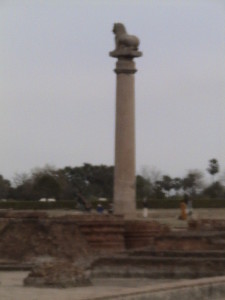 It is situated at Kolhua about 3.5 km north- west from Vishwa Shanti Stupa. Emperor Ashoka built this Lion Pillar with no inscription. It is made of a highly polished single piece of red sandstone, surmounted by a bell shaped capital, 18.3 m high. A life-size figure of a lion is placed on top of the pillar. This pillar is different from the earlier Ashokan pillars because it has only one lion capital. The lion faces north, the direction Buddha took on his last voyage.
It is situated at Kolhua about 3.5 km north- west from Vishwa Shanti Stupa. Emperor Ashoka built this Lion Pillar with no inscription. It is made of a highly polished single piece of red sandstone, surmounted by a bell shaped capital, 18.3 m high. A life-size figure of a lion is placed on top of the pillar. This pillar is different from the earlier Ashokan pillars because it has only one lion capital. The lion faces north, the direction Buddha took on his last voyage.
Ramkund Tank(Markathad) :-
It is lie to the south of Ashoka Pillar. It is said in the ancient texts that it was the place where a local chief of monkeys had offered a bowl of honey to Buddha. This event has been marked among one of the eight significant events in the life of Buddha. The tank is believed to be made by monkeys for Buddha, hence named as Markata-Hrid. The tank made of brick and mortar measures up to 200 ft in length and about 100 ft in width.The measurement of the bricks used in itsconstruction is 15.5″ x 9.5″ x 2″ and water from river on the west used to drain into it. On the bank of the pond in the west direction, facilities for
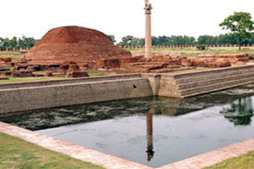 changing of clothes for the ladies and gents can be found. In course of excavation on the north-west direction of the pond, one large Nandi idol was also found. It is located around 100 feet south-west of Ramkund. In it some smaller and some large rooms are made. The measurement of bricks in this construction is same as that of the Ramkund.According to the descriptions of Buddhist literature and Chinese travellers, this construction would have been the part of “Mahaban Kutagarsala and Mahaban Mahabir”.
changing of clothes for the ladies and gents can be found. In course of excavation on the north-west direction of the pond, one large Nandi idol was also found. It is located around 100 feet south-west of Ramkund. In it some smaller and some large rooms are made. The measurement of bricks in this construction is same as that of the Ramkund.According to the descriptions of Buddhist literature and Chinese travellers, this construction would have been the part of “Mahaban Kutagarsala and Mahaban Mahabir”.
Anand Stupa :-
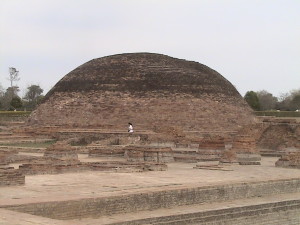 Near Ashoka Pillar, a Stupa, built by Licchavi on the mortal remains of the main disciple of Lord Buddha named Anand is lie. According to Buddhist Literature, Anand, after Buddha’s Mahaparinirvana (543 BC) after serving Buddhist Monasteries wanted to attain Nirvana in Vaishali & thus desired cross The Ganges to attain Nirvana on the other side. On hearing news Magadh King Ajatashatru came to him & requested him to attain Nirvana in Magadh. By then Lichhavi had also crossed the river Ganges, therefore, Anand could attain Nirvana at his desired place. Considering this, Anand in order to avoid a war between the two states, immolated himself in the middle of the river Ganga with the help of his yogic power. Thus half of his mortal remains went to the Republic of Lichhavi and the other half went to the Kingdom of Magadha. With the half of the mortal remains Lichhavi constructed ‘Ananda Stupa’ in Vaishali and Ajatshatru constructed another ‘Ananda Stupa’ in Rajgir, Nalanda. Stupa height from the ground level is 17 feet and the diameter is of 65 inches. It is wholly made of bricks. The measurement of the brick used is 12″ x 9.5″ x 2.5″. Over the stupa, there was a temple previously which was seen in 1862 by General Alexander Cunningham. In this temple, there was a beautiful Pala period Bodhisattva idol made of black stone. At present, this idol is with Vaishali Museum. Over this idol, something is inscribed which can be read as well. The Chinese traveller and Cunningham are of the view that here is the half-way monument of Ananda where Ashoka worshipped.
Near Ashoka Pillar, a Stupa, built by Licchavi on the mortal remains of the main disciple of Lord Buddha named Anand is lie. According to Buddhist Literature, Anand, after Buddha’s Mahaparinirvana (543 BC) after serving Buddhist Monasteries wanted to attain Nirvana in Vaishali & thus desired cross The Ganges to attain Nirvana on the other side. On hearing news Magadh King Ajatashatru came to him & requested him to attain Nirvana in Magadh. By then Lichhavi had also crossed the river Ganges, therefore, Anand could attain Nirvana at his desired place. Considering this, Anand in order to avoid a war between the two states, immolated himself in the middle of the river Ganga with the help of his yogic power. Thus half of his mortal remains went to the Republic of Lichhavi and the other half went to the Kingdom of Magadha. With the half of the mortal remains Lichhavi constructed ‘Ananda Stupa’ in Vaishali and Ajatshatru constructed another ‘Ananda Stupa’ in Rajgir, Nalanda. Stupa height from the ground level is 17 feet and the diameter is of 65 inches. It is wholly made of bricks. The measurement of the brick used is 12″ x 9.5″ x 2.5″. Over the stupa, there was a temple previously which was seen in 1862 by General Alexander Cunningham. In this temple, there was a beautiful Pala period Bodhisattva idol made of black stone. At present, this idol is with Vaishali Museum. Over this idol, something is inscribed which can be read as well. The Chinese traveller and Cunningham are of the view that here is the half-way monument of Ananda where Ashoka worshipped.
Kutagarasala Vihara is the monastery where Buddha used to stay during the rainy season spent at Vaisali. Excavations have exposed its three phases construction period. Originally it was a small chaitya build during Sunga-kushan period, In second phase it was enlarged to a lofty Temple in Gupta period and finally it was converted into a monastery during post Gupta Times.
Swastika Shaped Monastery :-
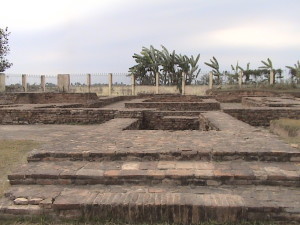
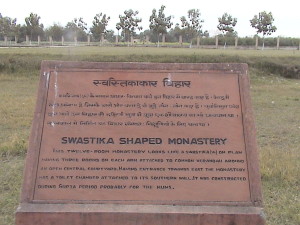 Excavation brought to light Gupta period , a twelve – room monastery looks like a Swastika on plan, probably constructed for the Nun, having three rooms on each arm attached to common verandah around an open central courtyard. Having entrance towards east . The Monastory has a Toilet chamber attached to its southern wall.
Excavation brought to light Gupta period , a twelve – room monastery looks like a Swastika on plan, probably constructed for the Nun, having three rooms on each arm attached to common verandah around an open central courtyard. Having entrance towards east . The Monastory has a Toilet chamber attached to its southern wall.
Bakhari :- It is about 1/2 km north of Ashoka Pillar. There are two ancient Stupas one 183 feet in diameter and 25 fit high and other is 179 fit in diameter and 23 fit high.The local people call it the “Bharof Bhimsen” or the “Palla of Bhimsen”. These two “Tilah” are very ancient monuments and were made of soil at many places. Such monuments have been found in India. Fahain also describes in his reference.
Ambara Chowk :- Ambara Chowk is situated about 40 km from Muzaffarpur in Saraiya Block on the Muzaffarpur – Rewa road. It is believed to be the home village of Amrapali, the famous Nagarvadhu of Vaishali.
Kund Gram :- According to a Jain tradition Lord Mahavira, 24th and the last of the Tirthankaras (599-527 BC) was born at Kundagrama at the home of King Sidharth. His mother’s name was Trishala. The location of Kundagrama is identified with the modern village of Basu Kund, about 2 kms north-east of the Vaishali garh mound. Mahavira is said to have spent the first 22 years of his life here.
Jain Mandir (Basu Kund) :- This temple has a very ancient, impressive and glorious history. It is connected with Bhagawan Mahavira. This is the place of the three Kalyanakas (events beneficent the world) – Garbha, Janma and Diksha Kalyanak of Lord Mahavir, according to the Digambar belief.
The Prakrit Jain Ological and Ahinsa Research Institute (Basu Kund):- The foundation stone of the Institute Building was laid at Basu Kund by the First President of Indian Republic, Dr. Rajendra Prasad on April 23, 1956. The Institute is located in an entirely rural environment, quite peaceful and congenial to serious and sustained studies.
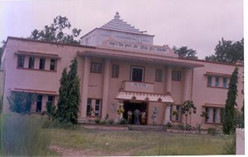 The objective of the Institute was to make it a residential centre of higher study and research in a Prakrit languages and literature, Jainology in all its branches, the principle and technique of Ahimsa and its practice both by the individual and society. The Institute has a well equipped library. The Institute runs Post-graduate classes and Research (Ph.D and D.Litt. degree) The examinations are organised by the B.R.A. Bihar University, Muzaffarpur. The Institute have other activities are Seminars, Memorial Lecturers, Popular Lectures, & special lectures etc.
The objective of the Institute was to make it a residential centre of higher study and research in a Prakrit languages and literature, Jainology in all its branches, the principle and technique of Ahimsa and its practice both by the individual and society. The Institute has a well equipped library. The Institute runs Post-graduate classes and Research (Ph.D and D.Litt. degree) The examinations are organised by the B.R.A. Bihar University, Muzaffarpur. The Institute have other activities are Seminars, Memorial Lecturers, Popular Lectures, & special lectures etc.
Kammal Chahra :- The place identified as where the Bhagwan Mahavira had his first Aahar (food).
Narsan Garh:- The KP Jayaswal Research Institute, during in the course of its Archaeological Explorations brought to light the site period Early medieval. Rewa Dih:- The KP Jayaswal Research Institute, during in the course of its Archaeological Explorations brought to light the site period Early medieval. Bakhara:– The KP Jayaswal Research Institute, during in the course of its Archaeological Explorations brought to light the site period NBPW phase.
Serukahi:- There is a tomb of a Muslim saint.
KANTI BLOCK
Mazar (Kanti) :- Kanti is an important and progressive village about 15 kms from Muzaffarpur to the west on the NH 28. Mazar of a Muslim saint is situated on a Man (water channel), which draws a large crowd throughout the year.
Kothiya Mazar :-
Birpur :-Excavation done in year 61-62 revealed three period of occupation with a 2.59 m thick deposit. Excavation yielded, the red , black and grey wares of medium fabric, terracotta naga figurines, beds, variously of terracotta carnelian and steatite, and a solitary tanged arrow head of bone etc.
Merpasauna :- A mound locally known as Merpasauna is situated in the north-western corner of the Birpur-chaur. Excavation done in year 61-62 revealed that the site belonged to the late phase of Shunga period.
Kushi Garh:- There is a twin ancient mound and ring wells. A small scale excavation done in year 87-88 on the south-western corner of the ancient mound. Result is that the remains of a semi-circular brick platform were exposed, the diameter of which is 1.95 m and contained five course of brick bats. The important antiquities founding are terracota human figures, variety of beads and bowls, conical objects and seal and scalings. Few sherds of red ware, decorated stamped with incised design of fish and flowers were also found. The appearances included dishes, storage jars, lota, bowl, pitcher, handi, lamps, spouted pots etc.
According to Jayaswal Research Institute Archaeological Explorations this site belongs to Kushan period.
Sonbarsa Dih:- The KP Jayaswal Research Institute, during in the course of its Archaeological Explorations brought to light the site period Early medieval. Karja Dih:- The KP Jayaswal Research Institute, during in the course of its Archaeological Explorations brought to light the site period Early medieval. Barka Gaon Dih:- The KP Jayaswal Research Institute, during in the course of its Archaeological Explorations brought to light the site period Early medieval. Mustafapur Garh:-The KP Jayaswal Research Institute, during in the course of its Archaeological Explorations brought to light the site period Early medieval. Bishwanathpur Dih:- The KP Jayaswal Research Institute, during in the course of its Archaeological Explorations brought to light the site period Early medieval. Raksa Dih:- The KP Jayaswal Research Institute, during in the course of its Archaeological Explorations brought to light the site period Early medieval.
KATRA BLOCK
Katragarh :-The place is situated nearly 35 km northeast of Muzaffarpur, extended over an area of about 105 acres. It represents one of the finest ruins of the fortified cities that came into existence during the early historic period in Bihar. The legend is that the city was built by some Raja Chand whom we cannot identify with any of the historical personalities.The site was excavated over as many as five seasons from 1975-76 to 1979-80 . The site revealed, on excavations, as many as four cultural periods, the Mauryan Period (4th-2nd cent. B.C.), the Shunga period (2nd-1st cent. B.C.), the early Kushana (1st-2nd cent. A.D.) and the Pala period. (9th-10th cent. A.D.).The city was fortified during the Shunga period (2nd-1st century B.C.). Excavation revealed the fortification wall has a width of a single bricks, the floorings were made of rammed earth or paved with bricks. The construction period ot the fortification wall was a long process of making, and involved not less than three phases, In the first phase, a baked brick wall was raised around the city to fortify it. The second constructional phase witnessed a huge earthwork taking shape. A moat was dug around the settlement and the earth thus obtained was utilized to build mud-core of the fortification. The highlight of the third phase was the brick reinforcement over the earthen core built-up during the phase second. This was in form of sloping brick-worked sides. The fortification, moreover, had a few auxiliary structures, such as watch-towers and flights of steps leading to them. The earliest habitation strata, however, could not be reached at due to the oozing of the sub-soil water beneath the Mauryan habitational layers. Several idols, ornaments, earthen pots and other articles of historical importance have been found here in course of excavations.
Sewerage System(Katra):- A unique sewerage system was discovered at Katra about 1 km to the west of Katragarh. The main drain pipe was made of baked bricks, four bricks forming a circular hole. Besides other sewers made of baked clay pipes interlocked with each other and connected with the main drains were also found.
Marawa Dih:- The KP Jayaswal Research Institute, during in the course of its Archaeological Explorations brought to light the site period Early medieval. Jhaurapur:- The KP Jayaswal Research Institute, during in the course of its Archaeological Explorations brought to light the site period Early medieval. Chandanaha Dih:- The KP Jayaswal Research Institute, during in the course of its Archaeological Explorations brought to light the site period NBPW phase. Bakuchi Dih:- The KP Jayaswal Research Institute, during in the course of its Archaeological Explorations brought to light the site period Early medieval.
Chandahadih:- It is situated on the left bank of the Bagmati river, about 5 km north-west of Katragarh.The excavation revealed as many as Two cultural periods. Period first is represented by the northern black polished ware, beautiful terracotta plaques, animal and bird figurines, balls of various sizes etc. This period is datable to second century B.C to first century A.D. Period second is marked by the founding of red ware and the continuation of the grey ware from the earlier period Structural activity is represented by remains of a flooring with intact pots, ovens etc.The natural soil strata, however, could not be reached due to the high subsoil water level. During excavation archeological found is terracotta human and animals figurines, beds, pendants, beads of stone, glass and bones, bangle pieces of conch and fragments of copper and iron objects.
PAROO BLOCK
Kuari Dih:- The KP Jayaswal Research Institute, during in the course of its Archaeological Explorations brought to light the site period Early medieval. Ramchandrapur Dih:– The KP Jayaswal Research Institute, during in the course of its Archaeological Explorations brought to light the site period Early medieval. Rusalpur Dih:- The KP Jayaswal Research Institute, during in the course of its Archaeological Explorations brought to light the site period Early medieval. Ghayaspur Dih:- The KP Jayaswal Research Institute, during in the course of its Archaeological Explorations brought to light the site period Early medieval. Arar Lakshmipur:- The KP Jayaswal Research Institute, during in the course of its Archaeological Explorations brought to light the site period NBPW phase. Jafarpur Dih:- The KP Jayaswal Research Institute, during in the course of its Archaeological Explorations brought to light the site period NBPW phase. Basaitha Garh:- The KP Jayaswal Research Institute, during in the course of its Archaeological Explorations brought to light the site period Early medieval. Chhap Dih:- The KP Jayaswal Research Institute, during in the course of its Archaeological Explorations brought to light the site period Early medieval. Malahi Dih:- The KP Jayaswal Research Institute, during in the course of its Archaeological Explorations brought to light the site period Early medieval. Paroo Garh:-The KP Jayaswal Research Institute, during in the course of its Archaeological Explorations brought to light the site period Early medieval. Raghunathpur Dih:- The KP Jayaswal Research Institute, during in the course of its Archaeological Explorations brought to light the site period Early medieval. Nagawa Garh:–The KP Jayaswal Research Institute, during in the course of its Archaeological Explorations brought to light the site period NBPW phase. Rampur Kesho Dih:- The KP Jayaswal Research Institute, during in the course of its Archaeological Explorations brought to light the site period Early medieval. Bara Dih Kamalpur:- The KP Jayaswal Research Institute, during in the course of its Archaeological Explorations brought to light the site period Early medieval. Chandpur Dih:- The KP Jayaswal Research Institute, during in the course of its Archaeological Explorations brought to light the site period Medieval. Deoria Dih:- The KP Jayaswal Research Institute, during in the course of its Archaeological Explorations brought to light the site period Medieval.
MARWAN BLOCK
Bishundpur:- The KP Jayaswal Research Institute, during in the course of its Archaeological Explorations brought to light the site period Early medieval. Pakohi Dih:- The KP Jayaswal Research Institute, during in the course of its Archaeological Explorations brought to light the site period Early medieval. Karjan Dih:– The KP Jayaswal Research Institute, during in the course of its Archaeological Explorations brought to light the site period Early medieval. Mansoorpur Chamarua:- The KP Jayaswal Research Institute, during in the course of its Archaeological Explorations brought to light the site period NBPW phase. Bhatauna:- The KP Jayaswal Research Institute, during in the course of its Archaeological Explorations brought to light the site period NBPW phase. Chamarua Dih:- The KP Jayaswal Research Institute, during in the course of its Archaeological Explorations brought to light the site period NBPW phase.
SAKRA BLOCK
Sakra :- Sakra a block headquater is situated about 25 km south – east of Muzafferpur.It is famous for a temple with idols of Laxminarayan, Suryanarayan,Satyanarayan and Gauri Shanker which are said to be very old along with the temple .There are inscriptions in Pali script at the base of the idol of Lord Laxminarayan.
Sakreshwar Bhagwati Mandir (Sakra):-
Rampur Bhadson Dih:- The KP Jayaswal Research Institute, during in the course of its Archaeological Explorations brought to light the site period NBPW phase. Raghunathpur Donma:– The KP Jayaswal Research Institute, during in the course of its Archaeological Explorations brought to light the site period NBPW phase. Machhahi Dih:– The KP Jayaswal Research Institute, during in the course of its Archaeological Explorations brought to light the site period Early medieval. Patsawan:- The KP Jayaswal Research Institute, during in the course of its Archaeological Explorations brought to light the site period Early medieval. Qutubpur:- The KP Jayaswal Research Institute, during in the course of its Archaeological Explorations brought to light the site period Early medieval. Bakhri:- The KP Jayaswal Research Institute, during in the course of its Archaeological Explorations brought to light the site period NBPW phase. Ganiyari:- The KP Jayaswal Research Institute, during in the course of its Archaeological Explorations brought to light the site period Early medieval. Kuleshara Dih:- The KP Jayaswal Research Institute, during in the course of its Archaeological Explorations brought to light the site period NBPW phase. Sonbarsa Dih:- The KP Jayaswal Research Institute, during in the course of its Archaeological Explorations brought to light the site period NBPW phase. Methaura Dih:- The KP Jayaswal Research Institute, during in the course of its Archaeological Explorations brought to light the site period Early medieval. Lohar Gama:- The KP Jayaswal Research Institute, during in the course of its Archaeological Explorations brought to light the site period Early medieval. Beruadih:- The KP Jayaswal Research Institute, during in the course of its Archaeological Explorations brought to light the site period Early medieval. Bharwari:- The KP Jayaswal Research Institute, during in the course of its Archaeological Explorations brought to light the site period Early medieval. Jogni Ganga:- The KP Jayaswal Research Institute, during in the course of its Archaeological Explorations brought to light the site period Early medieval.
MOTIPUR BLOCK
Hathilwa-Math :- Hathilwa- Math is about 40 km from Muzaffarpur It is the famous temple, dedicated to Radha-Krishna.
Fateha Dih:- The KP Jayaswal Research Institute, during in the course of its Archaeological Explorations brought to light the site period Early medieval. Kathaiya Dih:- The KP Jayaswal Research Institute, during in the course of its Archaeological Explorations brought to light the site period NBPW phase. Bhakhara Dih:- The KP Jayaswal Research Institute, during in the course of its Archaeological Explorations brought to light the site period Early medieval. Pansalawa Dih:- The KP Jayaswal Research Institute, during in the course of its Archaeological Explorations brought to light the site period Later Gupta. Tajpur Dih:- The KP Jayaswal Research Institute, during in the course of its Archaeological Explorations brought to light the site period NBPW phase. Mohaddipur Dih:- The KP Jayaswal Research Institute, during in the course of its Archaeological Explorations brought to light the site period Gupta. Narwara:- The KP Jayaswal Research Institute, during in the course of its Archaeological Explorations brought to light the site period Early medieval. Jatauliya Dih:- The KP Jayaswal Research Institute, during in the course of its Archaeological Explorations brought to light the site period Gupta. Jasauli Dih:- The KP Jayaswal Research Institute, during in the course of its Archaeological Explorations brought to light the site period NBPW phase. Korauta Brahm Dih:- The KP Jayaswal Research Institute, during in the course of its Archaeological Explorations brought to light the site period NBPW phase.
AURAI BLOCK
Rajkhand:- It is situated about 5 km from headquarters of the Aurai block on Aurai-Saidpur road. There is an old temple of Bhairav Nath. A big cattle fair is held here every year on the occasion of Shivaratri festival.
.
Sarchiya:- The KP Jayaswal Research Institute, during in the course of its Archaeological Explorations brought to light the site period Early medieval.
Andaroon E Madarsa (Maqsoodpur):-
Sher E Bihar Maulana Mufti Aslam R.A
GAIGHAT BLOCK
Suwas Kunai:- The KP Jayaswal Research Institute, during in the course of its Archaeological Explorations brought to light the site period NBPW phase.
MINAPUR BLOCK
Tomb of Pir Damaria Shaheb( Minapur):- It is The tomb of Hazrat Mohiuddin alias Pir Damaria Shaheb .It is built of marble.
Tomb of Kamaluddin Shaheb(Minapur):-
Khaja Mohiuddin Chisti (Minapur):-
He was disciple of Baba Fariduddin Gunj Shakar Multani.
Neura:- The KP Jayaswal Research Institute, during in the course of its Archaeological Explorations brought to light the site period Early medieval.
Bhami Devi Temple (26 :30 :: 85 :15):- The site is temple of goddess Sati or Durga. It is said that right cheek of Sati Burnt body fell down here. The statue of marble in the temple is said to be found by a trader in river flood who later got it established in the temple.
DHOLI (MORAUL) BLOCK
Nautan:- The KP Jayaswal Research Institute, during in the course of its Archaeological Explorations brought to light the site period Early medieval. Moraul:- The KP Jayaswal Research Institute, during in the course of its Archaeological Explorations brought to light the site period Early medieval.
BANDRA BLOCK
Semra Dih:- The KP Jayaswal Research Institute, during in the course of its Archaeological Explorations brought to light the site period NBPW phase. Matlupur Dih:- The KP Jayaswal Research Institute, during in the course of its Archaeological Explorations brought to light the site period Early medieval. Pirapur Dih:- The KP Jayaswal Research Institute, during in the course of its Archaeological Explorations brought to light the site period Early medieval. Piar Dih:- The KP Jayaswal Research Institute, during in the course of its Archaeological Explorations brought to light the site period Medieval. Rampur Dayal DihTola:- The KP Jayaswal Research Institute, during in the course of its Archaeological Explorations brought to light the site period Early medieval. Bargawan Dih:- The KP Jayaswal Research Institute, during in the course of its Archaeological Explorations brought to light the site period Medieval. Ratwara DihTola:- The KP Jayaswal Research Institute, during in the course of its Archaeological Explorations brought to light the site period Early medieval. Maheshpur Dih:- The KP Jayaswal Research Institute, during in the course of its Archaeological Explorations brought to light the site period Early medieval. Tepri Dih:– The KP Jayaswal Research Institute, during in the course of its Archaeological Explorations brought to light the site period NBPW phase. Bahadurpur Garh:- The KP Jayaswal Research Institute, during in the course of its Archaeological Explorations brought to light the site period Early medieval.
KURHANI BLOCK
Arispur (Kalyanpur):- The KP Jayaswal Research Institute, during in the course of its Archaeological Explorations brought to light the site period Kushan
Kharauna:– The KP Jayaswal Research Institute, during in the course of its Archaeological Explorations brought to light the site period NBPW phase.
Turki:- The KP Jayaswal Research Institute, during in the course of its Archaeological Explorations brought to light the site period NBPW phase.
Turki Math :-
Anjan Tree :- It is the tree which is not identified yet. Two no of this type of tree only found in the world . One in near Railway outer post of Turki Staion.
Gorigama:– The KP Jayaswal Research Institute, during in the course of its Archaeological Explorations brought to light the site period Early medieval. Sumera:- The KP Jayaswal Research Institute, during in the course of its Archaeological Explorations brought to light the site period NBPW phase. Gaurihari:- The KP Jayaswal Research Institute, during in the course of its Archaeological Explorations brought to light the site period NBPW phase. Barkurwa:- The KP Jayaswal Research Institute, during in the course of its Archaeological Explorations brought to light the site period NBPW phase. Jamrua (Lalpur Harbansh):- The KP Jayaswal Research Institute, during in the course of its Archaeological Explorations brought to light the site period NBPW phase. Bishnupur Giddha:- The KP Jayaswal Research Institute, during in the course of its Archaeological Explorations brought to light the site period Early medieval. Bachhuman:- The KP Jayaswal Research Institute, during in the course of its Archaeological Explorations brought to light the site period NBPW phase. Chanhua:- The KP Jayaswal Research Institute, during in the course of its Archaeological Explorations brought to light the site period NBPW phase. Bisauli:- The KP Jayaswal Research Institute, during in the course of its Archaeological Explorations brought to light the site period Medieval. Madhopur:- The KP Jayaswal Research Institute, during in the course of its Archaeological Explorations brought to light the site period NBPW phase. Bangra:– The KP Jayaswal Research Institute, during in the course of its Archaeological Explorations brought to light the site period NBPW phase. Kinaru:- The KP Jayaswal Research Institute, during in the course of its Archaeological Explorations brought to light the site period NBPW phase. Ladaura:- The KP Jayaswal Research Institute, during in the course of its Archaeological Explorations brought to light the site period Early medieval.
Dhamma Licchavi :- It is situated at Ladaura, about 20 km from Vaishali. It is about 12 km from Muzaffarpur. Dhamma Licchavi aims to promote the practice of Vipassana, one of India’s most ancient meditation techniques. Vipassana is the practical spirit of the teachings of Buddha, who taught Dhamma – the Universal Law of Nature.
Kermadih:- The KP Jayaswal Research Institute, during in the course of its Archaeological Explorations brought to light the site period NBPW phase. Balia:– The KP Jayaswal Research Institute, during in the course of its Archaeological Explorations brought to light the site period Early medieval. Kishunpur Madhuwan:- The KP Jayaswal Research Institute, during in the course of its Archaeological Explorations brought to light the site period Kushan. Tarsan Dih:- The KP Jayaswal Research Institute, during in the course of its Archaeological Explorations brought to light the site period NBPW phase. Thuhma:- The KP Jayaswal Research Institute, during in the course of its Archaeological Explorations brought to light the site period NBPW phase. Padmaul:- The KP Jayaswal Research Institute, during in the course of its Archaeological Explorations brought to light the site period Early medieval. Amarkha:- The KP Jayaswal Research Institute, during in the course of its Archaeological Explorations brought to light the site period Later Gupta. Anwara:-The KP Jayaswal Research Institute, during in the course of its Archaeological Explorations brought to light the site period Gupta . Jawa:– The KP Jayaswal Research Institute, during in the course of its Archaeological Explorations brought to light the site period NBPW phase.
